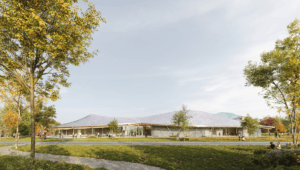Defacing the work of Le Corbusier has become something of a trend of late. However, Paris-based Swiss artist Felice Varini has taken a more elegant approach to the fad. Using optical illusions, Varini’s art installation, À Ciel Ouvert (Open Air) is located on top of Le Corbusier’s La Cité Radieuse, built in 1952, an iconic modernist structure.
“This is the first time that I have exhibited on, in, and with architecture designed by Le Corbusier,” said Varini in a press release. “This place is a landmark, a huge influence. It is a true microcosm, designed as a small city with its range of complex volumes, a small city with a view over the large city of Marseille. It is extremely exciting!”
Famed for his illusory artwork, Varini has applied his hallmark approach to numerous buildings-turned-canvases over the years. His work ranges from cellars to gothic churches, town squares, and a variety of urban environments. The art, by nature, relies on perspective and orientation. His style features a fragmented geometric aesthetic: circles, triangles and linear forms interact while others fall apart upon the concrete surface of the house. “My concern is what happens outside the vantage point of view,” said Varini in 2008.
Speaking of his work on La Cité Radieuse, he added: “I generally scour the venue taking in its architecture, materials, history and function. Based on its varying spatial data, I define a viewpoint around which my initiative takes shape. For me a viewpoint is a point in the space that I choose carefully: it is usually situated at my eye level and preferably located in a key passageway, for example where one room leads to another, a landing, etc. I don’t make a rule of it, as spaces don’t all systematically have an obvious path.”
“The choice is often arbitrary. The viewpoint will function like a point of interpretation, that is, like a potential starting point to approach the painting and the space. The painted form makes sense when the spectator is in this spot. When the spectator leaves the viewpoint, the work encounters the space generating an infinite number of views of the shape. Therefore I do not see the accomplished work through this first point; this is encompassed in all the views that the spectator may have of it.”










